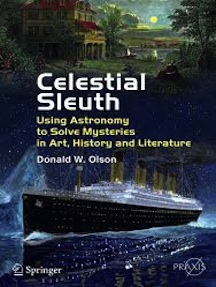By Jay M. Pasachoff
Some of the best known oil paintings by major artists can be better understood with the use of astronomy and related sciences. Munch’s The Scream has a red sky and his Starry Night has, obviously, stars. Several of Van Gogh’s paintings, not limited to his own Starry Night, have stars, Venus, or the Moon.
Don Olson, a professor of astronomy at Texas State University in San Marcos, Texas, has worked out a method of identifying locations and times for paintings from a combination of astronomical circumstances—such as shadows, tides, and positions of the moon and stars in the sky—and contemporary records such as journals or diaries. He regularly takes a class of his students to a remote location to carry out the research. For example, he and his students could match the exact date and location on the beach in 1883 in Étretat, Normandy, at which Monet painted an oil. He could even pinpoint the time to 4:53 in the afternoon. His book, incorporating a variety of subjects some of which had been covered in articles in Sky & Telescope magazine, leads us through the reasoning behind his discoveries.
Another of his student fact-finding trips was to Norway to pin down the position from which Edvard Munch painted and drew several works of art. A road, a cliff in the distance, and the dates of an Indonesian volcanic eruption all played a part in the identification. As in some other cases as well, his group discovered that a historical marker already in place in Norway for the Scream was in the wrong place!
A particular favorite of mine in his work is Olson’s identification of the exact location and time of Ansel Adams’s famous Yosemite photograph Autumn Moon. His discussion includes Adams’s record of the eclipse comet of, we learn, 1948, the Metonic cycle of lunar positions, and Adams’s own records. As information of their conclusion spread, some 300 photographers showed up on the 2005 day that matched the lunar position shown in Adams’s photograph. Olson pinpointed the color version to 7:01 pm DT on September 15, 1948, with the black-and-white version at 7:03. The next such opportunity will come on September 15, 2024 (a few months, I might add, after the April 8, 2024, total solar eclipse that will be visible in the U.S. from Texas to Maine).
A second part of Olson’s book involves figuring out locations and sometimes exact times for historical events. His work pinned down, for example, the Battle of Marathon in 490 BC, found the date ad location of Julius Caesar’s landing in Britain in 55 BC, and clarified which of many portrayals of the Boston Tea Party of 1773 showed the correct lunar phase. Where the iceberg that the Titanic hit came from also was revealed through his analysis. Some of his fascinating events involved World War II, including the brightness and the moon at the time of Pearl Harbor in 1941 and how the attack date was chosen incorporating astronomical reasons, and how the tides affected an allied landing at the Tarawa Atoll in the Pacific in 1943.
In a final part of the book, Olson brings his methods to bear on literary matters. He discusses the tides relevant to the Franklin’s tale in Chaucer’s The Canterbury Tales, and the bright star in the sky referred to in the beginning of Hamlet, thoroughly convincing us that it was the supernova seen by Tycho Brahe and others, including eight-year-old William Shakespeare, in 1572. William Blake, Mary Wollstonecraft Shelley, Walt Whitman, and James Joyce are among others whose literary works are placed in an astronomical context.
I found Olson’s book delightful and interesting to read, as it linked the science of the skies with human events.
Astronomer and author Jay Pasachoff is the director of Hopkins Observatory and Field Memorial Professor of Astronomy at Williams College.




